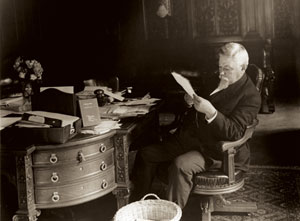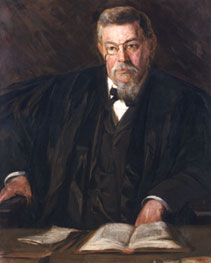Samuel Whitaker PennypackerSamuel W. Pennypacker was born in Phoenixville, Chester County, on April 9, 1843. His grandfather, Matthias Pennypacker, was a member of the General Assembly and president of the Philadelphia and Reading Railroad. He also helped write the state Constitution of 1837. His mother, Anna Maria Whitaker, came from a family that owned a local ironworks. His father, Isaac Pennypacker, was the first burgess of Phoenixville and held a professorship at the Philadelphia Medical College. As a young boy, Pennypacker attended Northwest Grammar School in Philadelphia from which he was given a scholarship at the Saunders Institute. However, before completing his studies, his father died of typhoid fever. The family returned to Phoenixville and lived with his maternal grandfather, Joseph Whitaker. Pennypacker completed his education at nearby Grovemont Seminary and prepared for Yale University. Unfortunately, his grandfather refused to provide tuition money, believing instead that his grandson should first prove himself in the workforce. In 1862 Pennypacker took an examination for his teachers' certificate in Montgomery County and that winter taught school in nearby Mont Clare. In 1863 he enlisted in Company F of Pottstown, 26th Pennsylvania Emergency Regiment. Convinced that his grandson had proven himself, Whitaker arranged for Pennypacker to study law at the University of Pennsylvania and apprentice in the law office of Peter McCall. In 1865, he was elected president of the Bancroft Literary Union. In 1866, he earned his bachelor of laws degree and established his own law practice. In the same year he was elected president of the Bancroft Literary Union and in 1868 was made president of the Law Academy of Philadelphia. By the end of the decade he received a doctorate of laws from Franklin and Marshall College. In 1886 Pennypacker was appointed to the Philadelphia Board of Education. He was admitted to the bar of the Supreme Court of the United States in 1887 and in 1889 Governor Beaver appointed him judge of the Court of Common Pleas of Philadelphia. Pennypacker later became president judge in 1897 and was re-elected for a ten-year term in 1899. He became president of the Historical Society of Pennsylvania in 1900 and served as a member to numerous scientific, historical, and patriotic societies. In 1902 Pennypacker ran against Robert Pattison in the general election. Pattison, who was the only Democrat to serve as governor between the Civil War and 1935, sought a third non-successive term after serving 1883-1887 and 1891-1895. However, Pennypacker had picked up the endorsements of veterans, agricultural interests, and former governor and Civil War hero James Beaver, and President Theodore Roosevelt, who publicly proclaimed that Pennypacker's defeat would be a "national calamity." Pennypacker defeated Pattison by more than 142,000 votes. As governor of Pennsylvania from 1903 to 1907, Pennypacker had an active political career. In 1903 Pennypacker signed legislation creating the Pennsylvania State Archives and in 1905 the legislation was signed to create the State Museum of Pennsylvania. Furthermore, the Departments of Health, Highways, Mines, and Fisheries were all created under Pennypacker, and the State Forestry Reserve was doubled. Pennypacker put forward the idea for the Pennsylvania State Police and signed the legislation in 1905. This was the first statewide police force and became a model for other states. The Pennsylvania State Police had a reputation of integrity and efficiency and even earned acclaim from President Roosevelt. The Child Labor Act of 1905 was another piece of significant legislation which set a minimum age for factory and mine work and outlawed most night work. On October 4, 1906, Governor Pennypacker dedicated Pennsylvania's new Capitol building, which he described as "the most elaborate and complicated constructive work ever undertaken by the state." Pennypacker believed that a grand and opulent public building would exalt Pennsylvania's status as the Keystone State. Today the Pennsylvania State Capitol serves as an icon of the State, representing history, government, and the richness of our Commonwealth. It remains an important historical and architectural landmark of Pennsylvania, drawing thousands of admiring visitors from around the world each year. |

